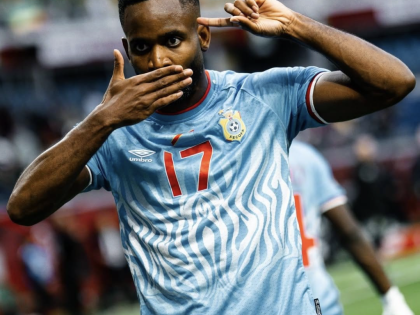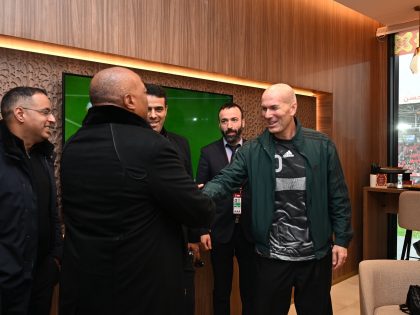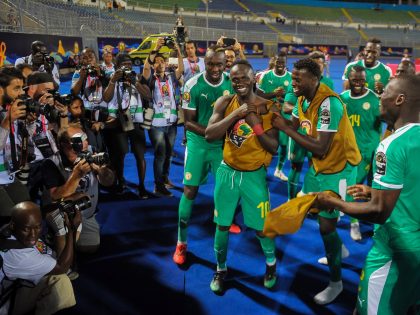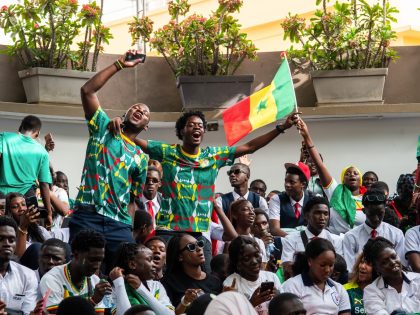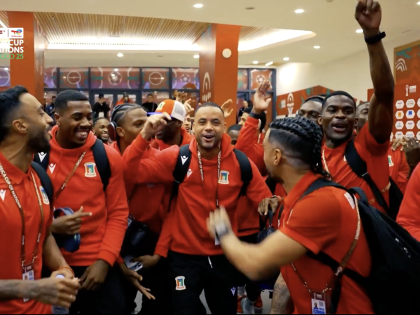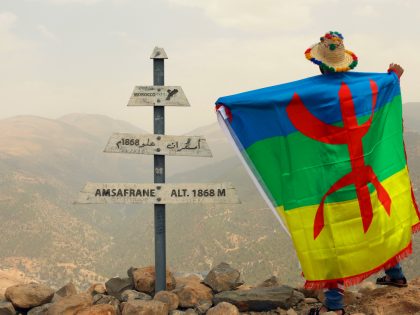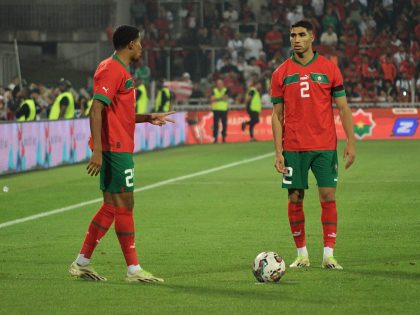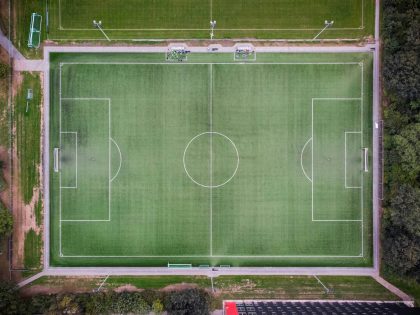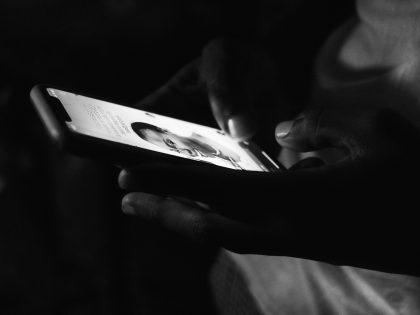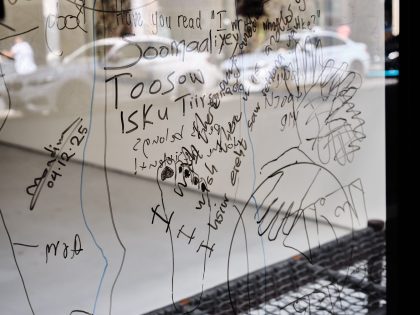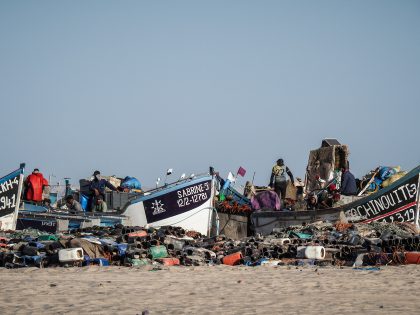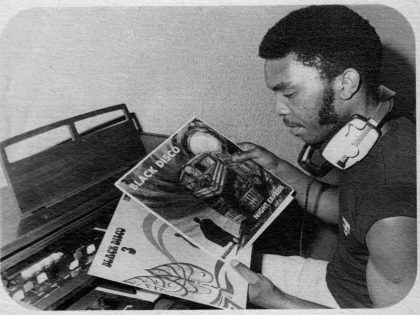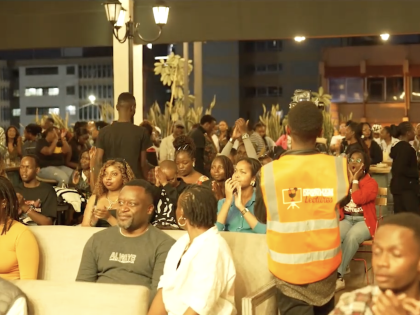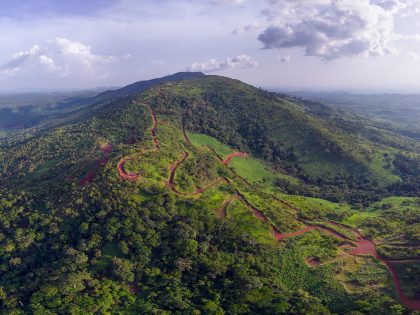On Safari
On our annual publishing break, Gaza’s genocide continues to unfold in real time yet slips from public grasp. This is not just a crisis of politics, but of how reality is mediated—and why we must build spaces where meaning can still take root.
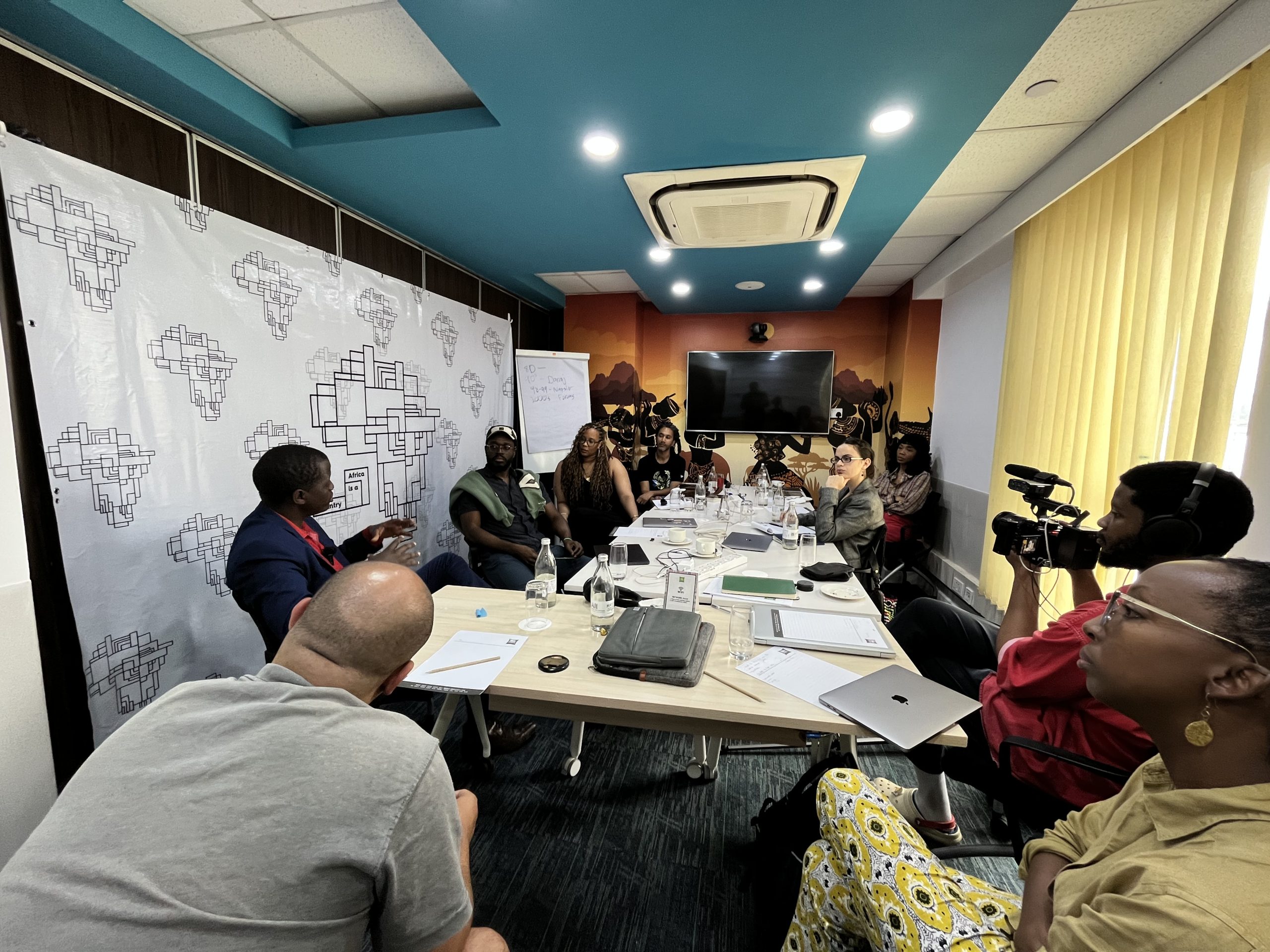
Africa Is a Country Festival conference session featuring Joe Kobuthi of The Elephant. Image credit Onesmus Karanja for AIAC.
This is now the fourth On Safari written under the shadow of genocide. Each time, Gaza has framed the horizon of our bi-annual publishing break—its destruction deepening, its images growing sharper and somehow harder to hold. We live in a moment where atrocity is not hidden but hyper-visible, live-streamed, endlessly shared. Still, with each passing month, the world seems to believe it less.
Earlier this August, BILD, Germany’s highest-circulation tabloid, published an article accusing Gaza-based photojournalist Anas Zayed Fteiha of staging scenes of Palestinian suffering to support “Hamas propaganda.” The piece offers no proof. It speculates and insinuates. It critiques not the content of Fteiha’s images but their composition: too aesthetic, too perfectly lit, too focused on children, on mothers, on chaos. It fixates on his affiliations, his Instagram posts, the tone of a painting he once shared. In place of evidence, it presents atmosphere. The reader is not asked to reason, but to doubt—to see grief, and suspect performance (In a grimmer register, while I was finalizing this piece to go to press, news broke that Anas al-Sharif, one of Gaza’s most prominent journalists and a reporter for Al Jazeera Arabic, had been assassinated in an Israeli airstrike along with four of his colleagues near Al-Shifa hospital. Israel claims al-Sharif was a senior Hamas operative, but offered no verifiable evidence beyond images it said were recovered from his phone.)
This is how genocide denial functions now. It rarely arrives as a blunt denial of death, but rather cloaked in concern for truth, in the language of skepticism, media literacy, and even professional ethics. It does not claim that Palestinians aren’t dying. It simply asks, “how do we know they’re dying like this?” It casts doubt on the camera, the angle, and the sequence. It suggests that even if the suffering is real, the image has already ruined it—by being legible, by being replicated, by being seen too many times.
What unsettles me is not just the cynicism of this attack, but its plausibility. That an article so conjectural, so evasive, so obviously enlisted in a project of erasure, could nonetheless shape the public mood, could cause even liberal readers to hesitate, to hedge, to ask: “well, how do we know?” And behind that question, something deeper: a growing disorientation, a fragmentation of our most basic political faculties—not only our capacity to discern what is true, but our sense that truth matters at all.
This is not simply a media problem. It is a crisis of subjectivity. A slow unravelling of our ability to perceive clearly, feel coherently, or act collectively in a world saturated by images, algorithms, and engineered doubt. This disorientation is not incidental to moments like this, but is their background condition. What we are seeing is not only a political struggle over Gaza and how it is understood, but a deeper transformation in how reality itself is mediated and experienced.
Something is breaking, and not just in the information we receive, but in the way we receive it. The disruption is not limited to facts or even trust. It extends deeper, into the terrain of perception itself. What we are living through is a corrosion of the cognitive and emotional capacities that political life depends on: the ability to pay sustained attention, to orient oneself within a shared reality, to hold complexity without collapse, to remember with clarity, and to feel in ways that match the weight of events.
Of course, disinformation is not new. Nor is propaganda, or paranoia. But, something about the current configuration feels more invasive. The tools at play no longer simply distort the content of thought; they now rewire its form. They bypass interpretation and operate instead on sensation; on mood, confusion, anticipation, and dread.
Digital platforms, especially those governed by algorithms optimized for engagement, have transformed the conditions under which we form and hold beliefs. They no longer simply present information to us, but structure our experience of the world, isolating us into feedback loops and fragmenting our sense of continuity. It is not that we do not see enough. It is that we see too much, too quickly, dwelling inside a kind of engineered disorientation. The feeds are endless and emotionally charged: the more extreme the content, the more visible it becomes.
This saturation does not always result in belief or disbelief. More often, it produces something quieter: a background hum of uncertainty, an erosion of confidence, a sense that the ground is no longer firm beneath our feet. We do not stop caring, but simply begin to feel less sure that we know how to care rightly, or what caring even looks like in this context. Whatever fragile, elite consensus on Gaza seemed to be building in recent months now feels stalled, even as famine deepens and Israel’s plans to expand its assault and take over Gaza City solidify. The moral urgency that briefly gathered in parts of the public has thinned, its energy dissipating as a new round of disciplinary backlash enters the stream—Britain arresting hundreds for supporting a Palestine solidarity group banned under political pretext; France halting Gaza evacuations after a Palestinian student was accused of an antisemitic post—even as both governments gesture toward recognizing a Palestinian state This is not unique to Gaza. The same pattern recurs elsewhere—in Sudan and the Democratic Republic of Congo, for example—where crises flare into visibility only to be absorbed into the churn and met with repression, their persistence stripped of political traction.
The recent proliferation of large language models only intensifies this condition. It’s no coincidence that AI, in its most widespread forms, now operates as a kind of hallucination machine. Large language models do not know what they’re saying. They simulate coherence by mimicking tone, drawing from probabilistic patterns in vast datasets. Their output is neither truth nor lie, but a fluent fog. And we—already attuned to fragmented context, suspicious of authority, primed for doubt—inhale it. The danger is not that we believe everything they say, but that we begin to lose confidence in our own perception and begin to internalize the confusion. That the fog settles inside us.
The writer L.M. Sacasas describes this as a form of “psychic enclosure.” That which was once shared—public attention, a common world, a stable interiority—has been sectioned off, parceled out, and rendered profitable. Our senses no longer reach out and return with clarity, since we no longer encounter the world directly. Our senses are increasingly filtered through systems designed to predict and shape our reactions.
Yet there are still experiences that cut through that enclosure, intense, raw, and unfiltered, impossible to scroll past or half-attend. In May, my daughter was born. Her arrival reorganized my world in ways that remain difficult to describe. Time changed its texture. The hours stretched and compressed around feedings, naps, and the endless work of keeping her safe. Even now, she teaches me that presence is not a metaphor. It is a daily obligation, a physical and emotional demand. You must show up, wholly, again and again. Not because children are innocent abstractions of the future, but because they are here, now, and they need you.
She has taught me something that I once knew in theory, but had never truly practiced: how to pay attention. Not the focused discipline of work, nor the distracted awareness that flickers between notifications, but the kind Simone Weil describes as the “rarest and purest form of generosity.” For Weil, attention is not about effort or strain. It is a kind of suspended openness, a willingness to be with what is there—not to grasp it, not to interpret it immediately, but simply to receive it in its fullness. Waiting, watching, and listening.
To care for a newborn is to live inside this form of attention. You must attune yourself to rhythms that are not your own and to signs that are not always legible (I have been around babies for good stretches of my life, but never this up close. I did not anticipate the weird and amusing world of their creaturely gestures, reflexes, and cues). There is no shortcut, no multitasking, no way to rush through the moment. You are asked to be present, wholly and repeatedly. This attention is exhausting, yes—but it is also, somehow, anchoring and expansive.
I won’t pretend to be the most attentive father in the world. At one in the morning, when my daughter has finally closed her eyes and I’m bouncing on the yoga ball for twenty minutes to make sure she stays asleep after transfer, I will—more often than not—end up scrolling on my phone. It’s a compromise: I get to zone out while keeping up the rhythm she finds reassuring. But in those moments, even in the half-light, I’m aware of the dissonance. One hand on my daughter’s back, the other thumbing through the feed. Her body breathing softly against mine while my eyes dart past war, sarcasm, celebrity gossip, famine, outrage, slopaganda, football transfer news, climate catastrophe, and death.
What she demands from me, and what I am so often unable to give, is precisely what the phone takes away: sustained attention, unbroken presence. This, too, is part of the contradiction. That the very device I turn to when I am tired or overwhelmed is the same one that is constantly reconditioning my nervous system to be less available to her, less responsive to the world.
If attention is a form of generosity, then we might say that it is also a form of freedom, because to attend is to choose how to spend one’s time, how to orient one’s being in the world. And in that sense, what we’re witnessing is not simply a cultural crisis, but a political and economic one. Under contemporary capitalism, time is not our own. It is exploited, monetized, fragmented, and sold back to us in the form of endless distraction. What we call attention is now subject to extraction by platforms, by algorithms, and by a media infrastructure that thrives on volatility and speed.
So when we say we can’t hold on to what we’ve seen, that it slips away from us, it is not only because the content is overwhelming. It is because the conditions of our lives no longer make room for sustained relation—to others, to events, to ourselves. The enclosure of attention is part of a larger enclosure: of psychic space, of emotional time, of the common world in which freedom might still mean something. We are haunted not just by the horror we see, but by the feeling that we are unable to respond to it in any meaningful way. That our very capacities—for solidarity, for memory, for judgment—are being quietly eroded.
In that sense, the crisis of attention is not ancillary to the genocide in Gaza. It is one of its conditions. What enables mass death is not only the West’s impunity and the enabling structures of empire. It is also the slow hollowing out of the foundations of moral and political engagement: the ability to remember clearly, to assess soberly, to commit over time, and to act with care. These do not disappear because people stop caring. Many care deeply—urgently, viscerally—but the conditions of digital life scatter that care, fracture it across a thousand stimuli, and make it difficult to carry anything through.
People are not passive. They have marched, organized, spoken out, and refused the enforced silence. But even amid that resistance, there is a heavy background sense of helplessness—a sense that what is happening exceeds our grasp, or repeats too quickly for us to interrupt it. The disorientation produced by digital life does not float above the world—it coexists with its material grind. With hunger and debt. With surveillance and repression. With the impossibility of rest. These are not separate but mutually reinforcing, locking people in a state of perpetual reaction, too breathless to sustain response. The contemporary right understands this better than most. Its politics are not only indifferent to the fraying of our cognitive and emotional resources, they depend on it. In the nihilism of the postmodern right, truth is a disposable commodity, reality is infinitely fungible, and cruelty is a form of entertainment. AI slop, deepfake propaganda, and algorithmically amplified harassment are not aberrations; they are tools for degrading the social capacities that collective politics requires. The more our sense of the common world is scattered, the easier it is to erode solidarity, and the harder it becomes to mount any sustained opposition to the violence they champion.
That is what makes Gaza feel so chillingly emblematic. Not only as an instance of settler-colonial and imperial violence, but as a preview of a world where atrocity is livestreamed and normalized; where witness and voyeur blur; where people know too much, too quickly, and still feel unable to act. As Colombian president Gustavo Petro put it, Gaza is a rehearsal of the future—not only in its violence and propaganda war, but in the deeper transformation of human subjectivity it reveals. One in which suffering is made ambient, part of the feed, part of the noise. The question is no longer whether people saw. It’s whether the world we live in still allows them to hold on to what they saw long enough, to make sense of it, to stay with it, to respond. And by respond, I do not mean a fleeting emotional reaction, or the temporary alibi of a shared post. I mean something more enduring: the work of understanding what made the violence possible; of placing oneself in relation to it; of allowing the encounter to change how one sees, what one values, what one is prepared to risk.
That kind of response—moral, political, sustained—requires capacities that are increasingly under siege. Not just memory and judgment, but time, focus, and long-term organization (which requires a sense of the future, a belief in political possibility). These are the casualties of digital life, but also of the broader political economy in which that life unfolds. When people are made to feel exhausted, precarious, and isolated, when their days are stretched thin by the rising cost of living and their nights shattered by doomscrolling, it becomes harder to carry anything through.
In December, I wrote that “there is no neutral ground” in the current media landscape, and that for a publication like ours, the question is not simply what we publish, but how—and on what terms. Over the past year, this has become more than an observation; it has become a guiding principle. At Africa Is a Country, we are working toward a theory of the media landscape—not as an abstract exercise, but as a way of mapping the terrain in which we operate, clarifying both our political responsibilities and the conditions under which our work can matter.
That is the context for the choices we made this year. We produced our first print edition: a carefully designed special issue reflecting on the “long decade” of global mass protest from 2008 to 2024. We hosted our first in person Africa Is a Country Festival in Nairobi, in partnership with NBO LitFest, Ukombozi Library, Qwani, and Revolutionary Papers, bringing together writers, artists, and activists for a week of collaborative programming. We screened our first feature-length documentary, After Oil, in Cape Town, Johannesburg, Nairobi, and Amadiba, using each screening as an occasion for public discussion. None of these projects are efficient in the capitalist sense. They are slow to make, expensive to produce, and difficult to scale. But this was the point in taking them on. Each was a deliberate refusal of the churn, a wager that time and sustained attention are not just desirable, but politically necessary.
The crisis of attention is not separate from the crises we cover. It is one of their conditions. The same systems that accelerate war, repression, and dispossession also corrode the forms of shared life that make political meaning possible. They fragment thought, scatter care, and erode the traits on which social solidarity depends. This is what some have called “social atrophy”: the steady loss of the skills, habits, and desires that sustain our ability to act together. Our work so far this year—the print edition, the Africa Is a Country Festival—has been an attempt, partial and imperfect, to resist that corrosion. Not by retreating into nostalgia for a vanished public sphere, but by helping to build a counterpublic and the infrastructure it needs: spaces and formats that can hold attention, nourish social life, and make it possible to think and act in common, even under conditions designed to pull us apart.
We do not do this work because we are nostalgic for a golden age of intellectual life. We do it because the conditions under which meaning becomes possible are being hollowed out by digital capitalism and the broader political economy of immiseration. Repairing those conditions is long-term work. It cannot be done alone, and it is not ours to do alone. It is participatory by design—rooted in the contributions of our editors, contributors, partners, and readers, and inseparable from the wider networks of thinkers, artists, and activists who share this commitment. And, it begins from a simple conviction: that the capacity for rigorous thought, deep attention, and imaginative vision is not the preserve of an educated elite, but a living resource in ordinary people. Our task is to help create the spaces, tools, and relationships that can draw out and connect those capacities, so that the work of making shared meaning and the work of making freedom can be undertaken together.
So we pause in August, as we always do, not as a retreat, but as part of this strategy. Rest is part of the infrastructure of sustained political and intellectual work. When we return in September, it will be with the same commitment: to create the time, space, and relationships in which it is still possible to think, argue, and imagine together—and to hold our attention, long enough, where it matters.
